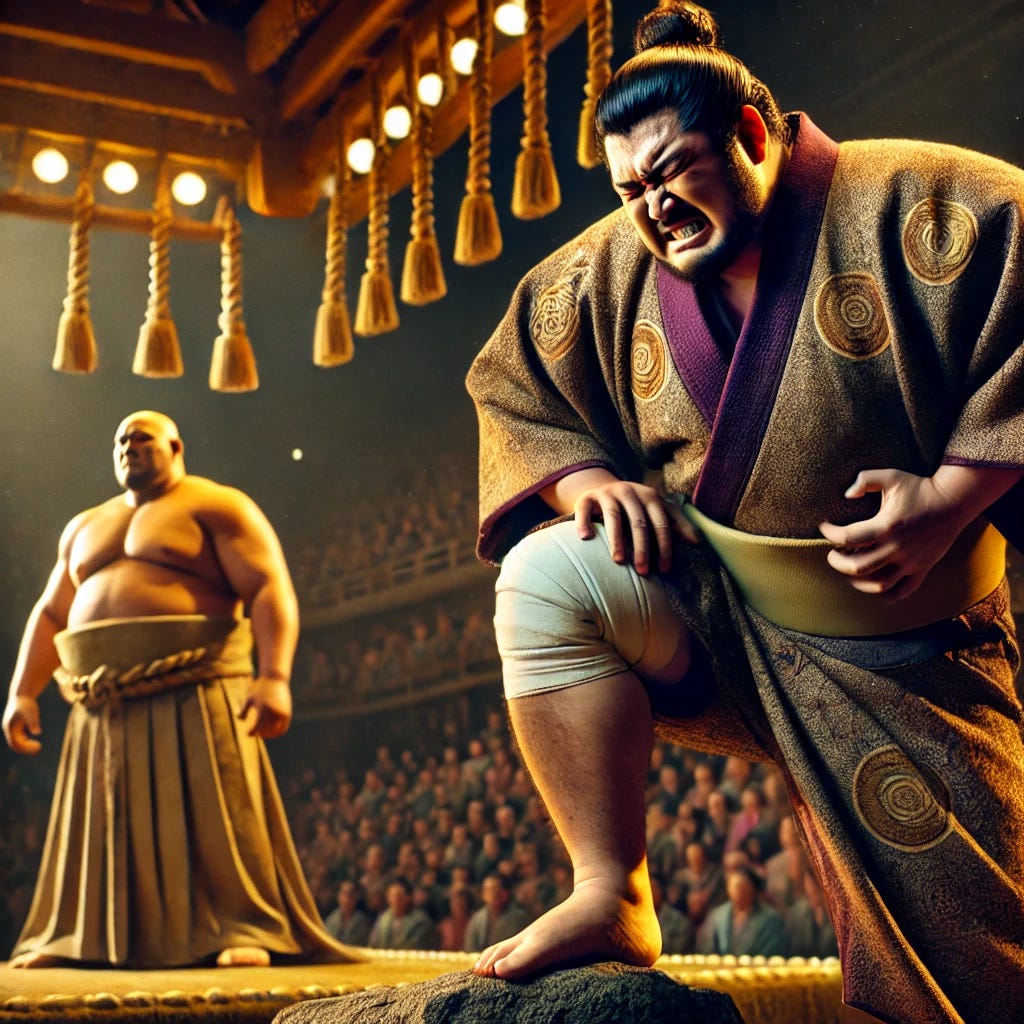It was a sunny day in late spring in Tokyo. A taxi pulled up outside the national sumo stadium—the Kokugi-kan (国技館). Out clambered a 350-pound behemoth in a summer kimono. This was Takanohana (貴乃花), a sumo grand champion. It was the fifteenth and last day of the May 2001 tournament.
Grand champions are the top wrestlers in the entire country and indeed the world. They are the strongest, smartest, and most skilled of all the wrestlers. Only a select few reach this exalted rank; Takanohana was the 65th grand champion—or “yokozuna”, as they are called—in the history of modern sumo.
In the fifteen-day tournaments that sumo has held six times a year for many decades, each wrestler fights one bout per day against one other wrestler. You might think it odd to fight just one match per day, but each match requires extensive preparation—mental and physical—and the utmost concentration. The best possible record for one tournament is 15-0. It is a remarkable achievement to win 15 matches in a row. It has happened only 74 times in the history of sumo. Takanohana, who already had accumulated 21 titles—meaning he won more bouts than any of the 30 other wrestlers in the top division—in his 11 years in the ring, had won them with perfect records four times, two of which were consecutive, a virtually unheard of feat, accomplished by only two other wrestlers in the history of the sport.
This is an astonishingly good performance. In terms of number of career tournament wins, Takanohana ranks sixth all-time. On this day, yet another title was at stake, with all the prestige and money that would accompany it. The prize money alone was nearly $100,000. And things were looking good. Going into the last day, he had a 13-1 record, one win ahead of his nearest competitor at 12-2. All he had to do was to win this bout, or his competitor lose his, and the huge Emperor's cup would be his. A day earlier, going into the 14th day, things had looked even better—he was 13-0, on his way to a perfect record with only two more wins. Sadly, his bout that day with Musōyama (武双山) did not go well, and Takanohana went down to his first defeat of the tournament, putting him at 13-1. Meanwhile, Musashimaru (武蔵丸), the Hawaiian wrestler who had been 11-2, won his bout to go to 12-2, just one win behind. The championship would be decided on the final day. All Takanohana had to do was to win his bout to clinch the championship.
The problem was that Takanohana had injured his knee—seriously—in that 14th day match against Musōyama. He had torn his ACL, the crucial tendon that connects the thigh bone (femur) to the shinbone (tibia). Such injuries are most often caused by rapid twisting, turning, or pivoting. They are commonly accompanied by a “popping” sound, and result in severe pain, swelling, limited mobility, and instability. Normally they would take six to nine months to heal, possibly longer for a professional athlete.
Takanohana’s father—the legendary long-time ozeki whose ring name the younger Takanohana had assumed upon becoming ozeki, and who was also his oyakata (stablemaster or coach), counseled him in the strongest terms to drop out of the tournament. The elder Takanohana was worried that his son the yokozuna could do long-lasting damage to his knee. If he did pull out, that would give Musashimaru a default win, leaving him tied with Takanohana at 13-2, which normally would trigger a playoff match—but being unable to take the ring, Takanohana would also lose that match by default, giving Musashimaru the championship.
To drop out of the tournament, handing the victory to his rival on a silver platter, did not even cross Takanohana’s mind. He rejected his father’s advice and mounted the ring for the final match of the final day, sadly losing to Musashimaru, leaving both with identical 13-2 records. The grueling match saw Takanohana’s knee buckle, but in this situation he was required to fight yet another match, a playoff—決定戦 or kettei-sen. The sumo titan rose again. On his way up onto the dohyo, his knee popped out and, grimacing in pain, he literally had to pop it back in, minutes before the playoff began.

But Takanohana’s resolve was unyielding. He won the playoff with a powerful overarm throw (uwatenage, 上手投げ), and with it his 22nd championship. It was the last tournament he would ever win. He did permanent damage to his knee that forced him to sit out the next seven tournaments—more than a year—and eventually retire in January 2003 at the age of 30.
Takanohana embodies the essence of the Japanese concept of “gambaru”—giving it your all.
Gambaru goes far beyond trying a little bit harder, or doing a little bit better than expected. It’s about pulling out all the stops, making the ultimate effort even in the face of prodigious odds and serious risk of failure.
Over the next few posts, I’ll be looking much more closely at this notion of gambaru from a number of vantage points, historical, linguistic, cultural. Join me.



